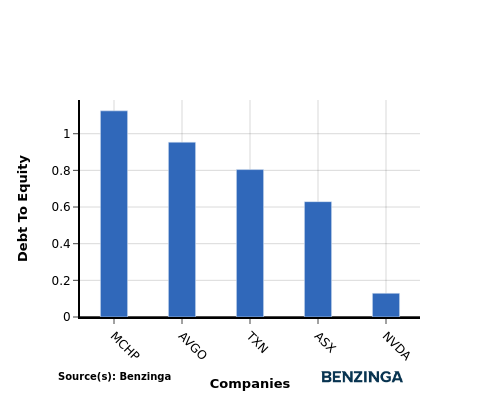Evaluating NVIDIA Against Peers In Semiconductors & Semiconductor Equipment Industry
In the dynamic and fiercely competitive business environment, conducting a thorough analysis of companies is crucial for investors and industry enthusiasts. In this article, we will perform an extensive industry comparison, evaluating NVIDIA (NASDAQ:NVDA) in relation to its major competitors in the Semiconductors & Semiconductor Equipment industry. By closely examining crucial financial metrics, market position, and growth prospects, we aim to offer valuable insights for investors and shed light on company's performance within the industry.
NVIDIA Background
Nvidia Corp is an upfront developer of graphics processing unit and a full-stack computing infrastructure company with data-center-scale offerings that are reshaping industry. Traditionally, GPU were used to enhanvce experience,now Nvidia offers AI GPUs, and also a software platform, Cuda, used for AI model development and training. The company is also expanding its data center networking solutions, helping to tie GPUs together to handle complex workloads. such as AI, model training and inference, data analytics, scientific computing, and 3D graphics, with vertical-specific optimizations to address industries ranging from healthcare and telecom to automotive and manufacturing.
| Company | P/E | P/B | P/S | ROE | EBITDA (in billions) | Gross Profit (in billions) | Revenue Growth |
|---|---|---|---|---|---|---|---|
| NVIDIA Corp | 34.63 | 31.31 | 19.35 | 30.42% | $25.82 | $28.72 | 77.94% |
| Taiwan Semiconductor Manufacturing Co Ltd | 23.12 | 6.33 | 9.37 | 9.05% | $596.09 | $512.38 | 38.84% |
| Broadcom Inc | 71.30 | 10.38 | 13.61 | 8.01% | $8.54 | $10.14 | 24.71% |
| Qualcomm Inc | 15.04 | 5.74 | 3.87 | 11.97% | $4.23 | $6.51 | 17.45% |
| Advanced Micro Devices Inc | 93.80 | 2.65 | 5.96 | 0.84% | $1.69 | $3.88 | 24.16% |
| Texas Instruments Inc | 31.58 | 8.84 | 9.65 | 7.02% | $1.92 | $2.31 | -1.72% |
| ARM Holdings PLC | 128.58 | 16.05 | 28.07 | 4.05% | $0.22 | $0.95 | 19.3% |
| Analog Devices Inc | 57.79 | 2.56 | 9.66 | 1.11% | $1.03 | $1.43 | -3.56% |
| Micron Technology Inc | 17.78 | 1.71 | 2.68 | 3.32% | $3.95 | $2.96 | 38.27% |
| Monolithic Power Systems Inc | 13.63 | 7.59 | 11.03 | 52.73% | $0.17 | $0.34 | 36.93% |
| Microchip Technology Inc | 71.42 | 3.63 | 4.65 | -0.87% | $0.21 | $0.56 | -41.89% |
| ASE Technology Holding Co Ltd | 18.92 | 1.85 | 1.01 | 2.95% | $30.11 | $26.62 | 1.05% |
| STMicroelectronics NV | 11.77 | 1 | 1.38 | 1.95% | $0.89 | $1.25 | -22.42% |
| United Microelectronics Corp | 11.45 | 1.42 | 2.33 | 2.28% | $29.73 | $20.43 | -0.16% |
| ON Semiconductor Corp | 9.80 | 1.70 | 2.17 | 4.37% | $0.62 | $0.78 | -14.65% |
| First Solar Inc | 11.33 | 1.83 | 3.48 | 5.05% | $0.58 | $0.57 | 30.68% |
| Skyworks Solutions Inc | 17.46 | 1.36 | 2.27 | 2.54% | $0.31 | $0.44 | -11.07% |
| Credo Technology Group Holding Ltd | 1237.67 | 10.20 | 20 | 4.95% | $0.03 | $0.09 | 154.44% |
| Lattice Semiconductor Corp | 97.91 | 8.34 | 11.70 | 2.33% | $0.02 | $0.07 | -31.17% |
| Qorvo Inc | 218.21 | 1.69 | 1.55 | 1.22% | $0.14 | $0.39 | -14.67% |
| Universal Display Corp | 25.31 | 3.46 | 8.66 | 2.87% | $0.06 | $0.12 | 2.51% |
| Average | 109.19 | 4.92 | 7.65 | 6.39% | $34.03 | $29.61 | 12.35% |
By closely examining NVIDIA, we can identify the following trends:
The Price to Earnings ratio of 34.63 is 0.32x lower than the industry average, indicating potential undervaluation for the stock.
The elevated Price to Book ratio of 31.31 relative to the industry average by 6.36x suggests company might be overvalued based on its book value.
With a relatively high Price to Sales ratio of 19.35, which is 2.53x the industry average, the stock might be considered overvalued based on sales performance.
The Return on Equity (ROE) of 30.42% is 24.03% above the industry average, highlighting efficient use of equity to generate profits.
With lower Earnings Before Interest, Taxes, Depreciation, and Amortization (EBITDA) of $25.82 Billion, which is 0.76x below the industry average, the company may face lower profitability or financial challenges.
With lower gross profit of $28.72 Billion, which indicates 0.97x below the industry average, the company may experience lower revenue after accounting for production costs.
The company's revenue growth of 77.94% exceeds the industry average of 12.35%, indicating strong sales performance and market outperformance.
Debt To Equity Ratio

The debt-to-equity (D/E) ratio assesses the extent to which a company relies on borrowed funds compared to its equity.
Considering the debt-to-equity ratio in industry comparisons allows for a concise evaluation of a company's financial health and risk profile, aiding in informed decision-making.
By evaluating NVIDIA against its top 4 peers in terms of the Debt-to-Equity ratio, the following observations arise:
NVIDIA has a stronger financial position compared to its top 4 peers, as evidenced by its lower debt-to-equity ratio of 0.13.
This suggests that the company has a more favorable balance between debt and equity, which can be perceived as a positive indicator by investors.
Key Takeaways
For NVIDIA, the PE ratio is low compared to peers, indicating potential undervaluation. The high PB and PS ratios suggest strong market sentiment and revenue multiples. The high ROE reflects efficient use of shareholder funds, while low EBITDA and gross profit may indicate operational challenges. The high revenue growth signifies strong top-line performance relative to industry peers in the Semiconductors & Semiconductor Equipment sector.
This article was generated by Benzinga's automated content engine and reviewed by an editor.